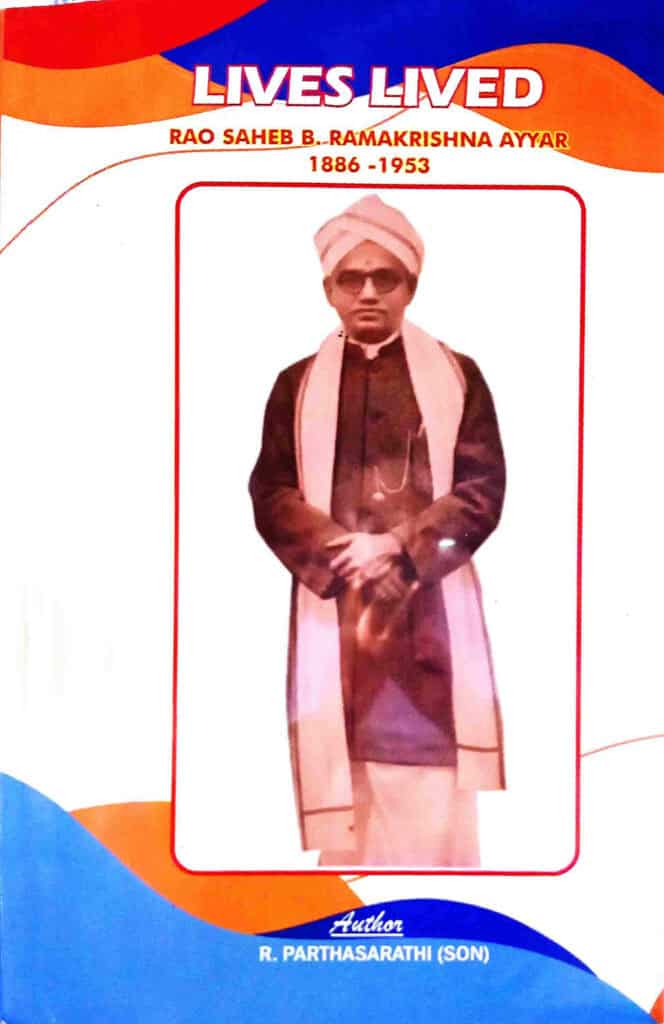“To forget one’s ancestors is to be a brook without a source, a tree without a root.” — Chinese Proverb
Lives Lived: Rao Saheb B. Ramakrishna Ayyar (1886–1953) – A Historian’s Reflection by Nagarjun Venkateshwaran
Author: R. Parthasarathi, son of Rao Saheb B. Ramakrishna Ayyar.
Theme of the book
The central theme of Lives Lived revolves around duty, legacy, and the enduring value of personal integrity. It portrays the life of an unsung civil servant whose commitment to family, work, and society served as a moral pillar during colonial India. Beyond the story of one man, the book echoes the fading ethos of a bygone era when simplicity, discipline, and public service were lived ideals. The book also subtly explores intergenerational respect, familial bonding, and cultural identity through the lens of a Tamil Brahmin household during the late 19th and early 20th centuries.
Narrative overview
 This book is not merely a biographical account of a man but a chronicle of a generation, a family lineage, and a historical phase in India’s evolution. Lives Lived delves into the life of Rao Saheb B. Ramakrishna Ayyar, a civil servant who dedicated his life to public service in the Madras Presidency. Written by his son R. Parthasarathi, the book beautifully combines familial intimacy with documentary authenticity.
This book is not merely a biographical account of a man but a chronicle of a generation, a family lineage, and a historical phase in India’s evolution. Lives Lived delves into the life of Rao Saheb B. Ramakrishna Ayyar, a civil servant who dedicated his life to public service in the Madras Presidency. Written by his son R. Parthasarathi, the book beautifully combines familial intimacy with documentary authenticity.
The narrative begins with ancestral portraits – Forefathers, Paternal and Maternal Relatives – revealing the proud heritage of the Ayyar family. These early chapters reflect deep-rooted Brahminical traditions, social customs, and religious fervor that shaped the environment in which B. Ramakrishna Ayyar was born and raised.
Chapters like Bala Sanyasi’s Agni Pariksha and My Father B. Ramakrishna Ayyar reveal the spiritual depth and moral rigour that formed the core of the family’s upbringing. The term Agni Pariksha symbolises the trials one must pass through in life, and B. Ramakrishna Ayyar, through a life of service, discipline, and personal restraint – epitomises this ideal.
His professional life unfolds in Services in the Madras Presidency and is detailed further in the chapters covering his birth, education, and career. What makes these chapters valuable is not just the listing of official postings, but the author’s effort to contextualise these in broader historical and administrative frameworks. We see glimpses of the British bureaucracy, the rigid yet prestigious Indian Civil Service, and the respect civil servants commanded during the colonial era.
Two chapters (B.R. Ayyar’s Personal Life in Service Time – Part 1 and 2) reflect the balance between the personal and professional. We learn of his disciplined habits, deep devotion to duty, and fatherly affection – all portrayed with an honest and sometimes emotional lens. The later years, described in Retirement, Evacuation Life in Tindivanam, and Retired Life at Madras, show a gentle winding down of a vibrant life into one of simplicity, reflection, and spiritual depth.
The final chapter, Father’s Farewell to All, is a heartfelt and dignified conclusion. It touches not just on his passing but also on how he was remembered – by family, colleagues, and the community. It is a fitting closure to a life lived in quiet glory.
The book is not written in flashy prose or with literary flourishes. Instead, its strength lies in truthfulness, sentiment, and detail. Through photographs, anecdotes, government postings, spiritual beliefs, and family memories, we understand the evolution of a man who served society selflessly and silently.
Personal reflections
As a student of history and someone who appreciates local and family chronicles, this book resonated with me on many levels. It reflects a time when values like honesty, service, simplicity, and discipline shaped individuals. B. Ramakrishna Ayyar’s story reminds us that not all legacies are loud: some are silently etched in the lives they touch.
I found this book emotionally engaging because it is not authored by a distant historian but by a son who saw his father not just as a public servant, but as a role model. The author, R. Parthasarathi, successfully conveys that dual perspective – with honesty and reverence.
Who can relate to this book
– Descendants of Civil Servants and freedom-era administrators
– History enthusiasts, especially those interested in the Madras Presidency
– Spiritual seekers
– Sociologists and anthropologists
– YouTube storytellers or researchers focusing on documenting ordinary heroes or forgotten figures in history
Recommendations for enhancement
1. Photographic enhancements
2. Contextual footnotes
3. Maps and family trees
4. More anecdotes
5. Digital access
Conclusion and rating
Lives Lived is a testament to a generation that believed in “service before self.” The author has carefully and lovingly recreated the life of his father not just through facts, but through the lens of respect, memory, and devotion. It is not a sensational biography. Instead, it is a silent salute to an era and a man who belonged to it.
It also highlights the importance of preserving family histories. In a time when digital media is overtaking oral traditions, books like this serve as living documents of heritage, reminding us to document our own.
Rating: 4.5 / 5
Reviewed and Penned by: Nagarjun Venkateshwaran, B.A. in History. Researcher and solo traveler.